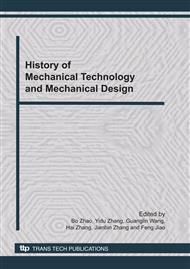p.200
p.204
p.209
p.215
p.219
p.224
p.228
p.232
p.236
System Design of Cam Mechanism Based on Fellower Structure and General Kinematic Laws
Abstract:
According to the different fellower structure and general simple trapezoid motion law of cam mechanism, this paper established a mathematic model for the motion of fellower structure of cam mechanism. The design method of motion law of the fellower structure was introduced, and the law of motion transition of fellower system and the related issues with program design were studied. A design system was developed using VB code based fellower structure and general motion laws. And the system could solve the curve of motion law for the fellower system and the eigenvalue of the curve, and finally realize parametric design of motion law for the fellower structure of cam mechanism. And the system could calculate and output the coordinate of cam configuration, and improve the digitized design process of cam parametric. The interface of the designed system is friendly and convenient, and the system could be used in both engineering and teaching.
Info:
Periodical:
Pages:
219-223
Citation:
Online since:
November 2010
Authors:
Price:
Сopyright:
© 2011 Trans Tech Publications Ltd. All Rights Reserved
Share:
Citation:


